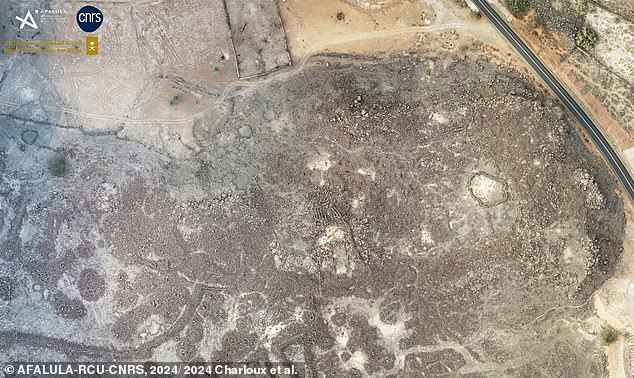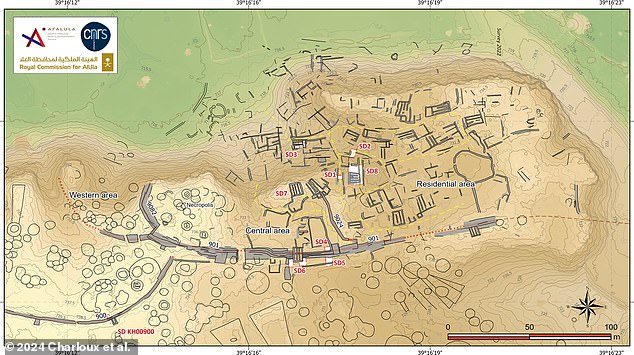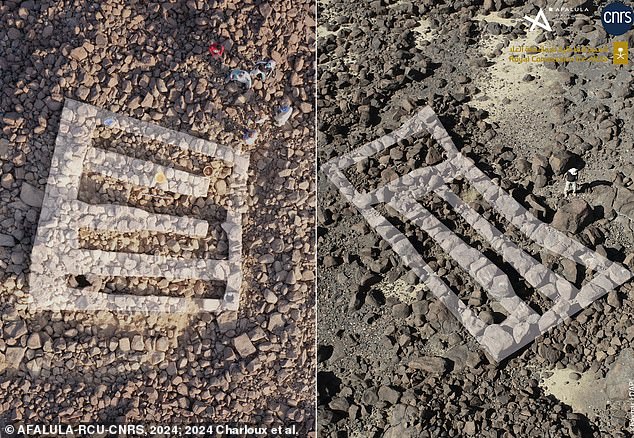Archaeologists unearth forgotten city in Arabian desert built by 4,000-year-old advanced ‘utopian’ society
Archaeologists have unearthed a forgotten city hidden in Saudi Arabia’s desert oasis that was built by an advanced society 4,000 years ago.
The fortified city, called al-Natah, was home to at least 500 people who were once nomads, but built at least 50 multi-story buildings in 2400 BC.
The ancient civilization built gigantic tombs that housed their remains and metal weapons, such as axes and daggers, that experts said were “advanced.”
Al-Natah was divided into a residential area, a decision-making zone and a necropolis connected by small streets and long trading networks.
Pottery fragments were also found among the dwellings, indicating an egalitarian society that prioritized the survival of the city.
This type of society is one where no social hierarchy exists and everyone is considered equal regardless of gender, race, class or wealth.
The 269,000 square meter settlement was hidden in a walled desert oasis of Khaybar on the Arabian Peninsula.
When the city was built, other areas along the Mediterranean were flourishing, from modern-day Syria to Jordan, but the oasis was previously thought to be an arid wasteland, dotted with graves and nomads.
The researchers created a 3D representation of what al-Natah would have looked like (photo). It included a necropolis in the center surrounded by residents’ homes and a 9-mile (14.9 km) wall surrounding the city.

The al-Natah site in the Khaybar Oasis (pictured) was discovered using satellite images from above
The earliest known city in human history was called Çatalhöyük, a settlement of about 10,000 inhabitants that existed in modern-day Turkey from 7400 BC to 5200 BC.
But researchers found that, unlike earlier cities, the ancient al-Natah people had built a process of “slow urbanization,” in which small, organized communities gradually adapted to life in the desert.
Pastoral nomads roamed northwestern Arabia since the early first millennium BC and among them was the Bedouin tribe who hunted, traded and plundered villages to obtain goods.
They depended on their herds of goats, sheep, and camels for food, cheese, milk, and other needs, forming family groups called clans that protected members from other nomadic tribes.
Archaeologists from the French National Center for Scientific Research in Paris reported that local nomads in the Early Bronze Age had decided to settle in a new community to protect themselves from raids.
The team said al-Natah was overlooked for so long because of the black volcanic rock – basalt rock that covered the area.
The basalt had hidden it so much that it “protected the site from illegal excavations,” French archaeologist and lead author of the study Guillaume Charloux said. AFP.
Al-Natah was first discovered 15 years ago when researchers observed the site using overhead satellites that revealed paths and the foundations of houses.
They created a 3D rendering of what the city looked like 4,000 years ago and said that while they identified only 50 homes, many may have been dismantled over the millennia.
That suggested the actual number could be between 55 and 70 houses.
According to the study, the thickness and configuration of the structures indicated that most were two or three stories high and all had foundations that were likely used as storage or crawl space.
“This type of construction is reminiscent of traditional Arab tower houses, especially the much later houses in the Najd region,” said the study, published in the journal PLOS Journalsaid.

A map of the al-Natah site (photo) shows where the ancient resident’s residences, tombs and necropolis were located in the city

There were at least 50 homes spread across al-Natah, but researchers said the actual number could be between 55 and 70. Pictured: a north-facing (left) and northwest-facing (right) dwelling at the al-Natah site
A dividing wall separated the dwellings from a necropolis filled with ‘staircase tombs’ – a tall, circular tomb with an outer wall and an inner burial chamber lined with stone pillars.
These graves suggested that the inhabitants carried out complex burial practices, while the weapons found in the cemeteries indicated that the people had a clear knowledge of metalworking.
The discovery of weapons combined with a fortified wall stretching 9 miles (14.9 kilometers) around the city indicated that the people were creating a way to defend themselves against possible raids, further strengthening their early urban lifestyle.
The largely populated area and the wall indicated that the inhabitants were laying the foundations for an ‘incense route’ in which spices, frankincense and myrrh were traded from southern Arabia to the Mediterranean.
Several wells and water sources were identified at the site, including one located at the foot of a nearby cliff that would have provided residents with a good water supply.
These findings are “proof that these ramparts are organized around a habitat,” Charloux told AFP.
The city was abandoned between 1500 BC and 1300 BC for unknown reasons, but researchers speculated that they could have left the area to return to nomadic life, due to illness or deteriorating climate.
